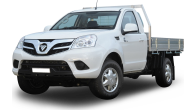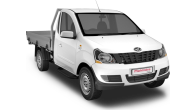The original Holden One Tonner was a runaway success so there was good reason for Holden to develop a new generation Commodore-based tray top. The original One Tonner was released with the HQ model in 1971 when it added a whole new dimension to the good old Aussie ute. At the time the traditional Aussie ute, basically a light three-quarter tonne workhorse, was under siege from a new wave of Japanese utes, which could all boast a full one tonne payload.
They might have been rough and rugged compared to the car-based ute, but the new imports were competitively priced and got the job done when your priority was work biased. The Holden One Tonner redressed the balance somewhat by offering local tradies a tough-as-nails work ute that could carry a full one-tonne payload with much of the comfort of a passenger car.
While it was a huge success there was no holding back the tidal wave that was the Japanese one-tonne utes, even Holden had one in the form of the Rodeo, and the Holden One Tonner was sent to the automotive graveyard in the mid-1980s.
The regular Holden ute carried on with a Commodore-based model after a short hiatus, but over time became less of a hard-core worker and more of a dual purpose work and play model. There are those within Holden who call it Australia’s own two-door sports car.
But there was always a demand from tradies who wanted a smart looking ute that was still capable of doing a hard day’s work.
Holden was in a sentimental mood when it released the new One Tonner based on the VY Commodore ute in 2003. It came in the wake of the new Monaro, which was then proving a hit with the car buying public, and that must have given Holden the confidence to resurrect another of its treasured icons of the past.
MODEL WATCH
Creating the new One Tonner wasn’t a simple cut and shut job on the Commodore-based Ute. The Holden ute didn’t have a chassis so the engineering team had to design an entirely new chassis frame and graft it to the Ute’s cabin.
The new One Tonner was part monocoque and part chassis frame. The frame was bolted on to the back of the cab rather than welded as is the more common practice, but Holden claimed its method of construction was a more robust one.
With a wheelbase of 3200 mm the new One Tonner was the longest in its class, and it was wider and higher than its Ute cousin. Importantly it had a payload capacity in excess of one tonne once allowance was made for fuel, passengers and additional equipment like tray bodies and bull bars etc.
The One Tonner lent itself to a broad range of body styles to suit the owner’s needs, from aluminium dropside trays to a stylish wooden flat top bed.
Up front the cab was the familiar comfortable Ute cabin with all of the Commodore features like cloth-trimmed bucket seats, centre console and power mirrors in the base model, while the ‘S’ model had air-conditioning, power windows, a leather-wrapped steering wheel and alloy wheels.
Buyers could choose from the 152 kW 3.8-litre Ecotec V6 with the Aisin 4L60 four-speed auto transmission, or the optional 225 kW 5.7-litre Gen III V8 which was available with the heavy-duty Aisin 4L65 four-speed auto or a six-speed manual gearbox.
Underneath the front suspension was the familiar Commodore MacPherson Struts with coil springs and an anti-roll bar, but the rear suspension was an all-new live rear axle with leaf springs, which was rated to carry 1800 kg.
A VZ update in 2004 brought the 175 kW Alloytec V6 engine, 10 kW more power for the V8, a six-speed manual transmission for the V6 and upgraded autos, and VZ styling.
IN THE SHOP
The One Tonner hasn’t been without its problems, most notably with the rear axle, which has been a constant source of drama for many owners. Gear noise and clunking has been the subject of regular complaints from owners and Holden’s answer has been to replace offending axles. Sometimes it has provided a satisfactory fix, other times it hasn’t.
One owner claims to have fixed the problem by increasing the oil capacity of the rear axle by fitting a larger hat available on the aftermarket.
In addition there is also the ongoing noise and oil consumption problems of the Gen III V8, so it’s worth checking for oil consumption records for a V8 One Tonner and carefully listening for any light tapping noises coming from the engine at idle or as the throttle is blipped. A check when the engine is cold might be enlightening as well.
Otherwise the One Tonner is a fairly robust unit, the economical ECOTEC 3.8-litre V6 stands up well and is probably the better buy if your priority is a workhorse. It’s quite economical with owners reporting fuel consumption numbers in the 10-12 L/100 km range.
The new Alloytec V6 is causing some consternation with owners reporting high oil consumption and disappointingly high fuel consumption in the region of 12-14 L/100 km.
Look for body damage caused by a hard life on the work site, One Tonners used for work purposes are exposed to a greater chance of accidental damage because they spend their time around moving equipment and carry tools and materials that can damage bodywork.
IN A CRASH
All models had a driver’s airbag as standard with the option of a passenger’s airbag.
Anti-skid brakes were standard on the ‘S’ model, optional on the base model.
OWNERS SAY
Mark Williams wishes he hadn’t bought VZ One Tonner. It was the 18-year-old chippie’s first car and he reckons it should have been painted lemon yellow instead of the black he ordered. The window tinting bubbled shortly after he took delivery of it, and in less than 22,000 km from new the Alloytec V6 has used oil at an alarming rate, the exhaust has been replaced, the brake rotors have been machined at least twice to fix its squealing brakes which continue to howl, and the auto transmission sometimes slips in first.
LOOK FOR
• Economical ECOTEC V6 in VY models
• high fuel consumption in Alloytec V6
• oil consumption and piston rattle in V8s
• full one-tonne payload
• sporty Commodore looks
• car-like comfort
• rear axle whine a sign of impending failure
THE BOTTOM LINE
Great idea but the One Tonner has been plagued with problems, particularly the rear axle, and it seems the new Alloytec V6 engine uses excessive oil and fuel.
RATING
50/100
Holden Commodore 2003:
| Engine Type | V6, 3.8L |
|---|---|
| Fuel Type | Unleaded Petrol |
| Fuel Efficiency | 0.0L/100km (combined) |
| Seating | 2 |
| Price From | $3,850 - $5,610 |
Pricing Guides


















.jpg)

.jpg)








.jpg)

